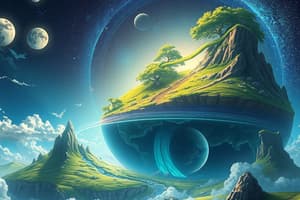Podcast
Questions and Answers
Which subsystem of the Earth encompasses all living organisms and their interactions with the environment?
Which subsystem of the Earth encompasses all living organisms and their interactions with the environment?
- Cryosphere
- Biosphere (correct)
- Hydrosphere
- Geosphere
What property of a mineral refers to its ability to resist scratching?
What property of a mineral refers to its ability to resist scratching?
- Luster
- Streak
- Hardness (correct)
- Cleavage
Which type of rock is formed from the cooling of molten material?
Which type of rock is formed from the cooling of molten material?
- Metamorphic
- Igneous (correct)
- Sedimentary
- Volcanic
Which energy resource is notably derived from decomposed organic materials?
Which energy resource is notably derived from decomposed organic materials?
Which of the following is NOT considered a freshwater source?
Which of the following is NOT considered a freshwater source?
What is the process called that includes evaporation, condensation, precipitation, and runoff?
What is the process called that includes evaporation, condensation, precipitation, and runoff?
Which property of minerals describes the color of the powdered form of the mineral?
Which property of minerals describes the color of the powdered form of the mineral?
Which type of mineral contains silicon and oxygen?
Which type of mineral contains silicon and oxygen?
Flashcards are hidden until you start studying
Study Notes
Subsystems of the Earth
- Geosphere: The solid part of the Earth, including rocks, sediments, and the ground.
- Hydrosphere: All water on Earth, encompassing oceans, rivers, lakes, and groundwater.
- Atmosphere: The layer of gases surrounding the Earth, crucial for weather and climate.
- Biosphere: The global sum of all ecosystems, including all living organisms and their interactions with the environment.
- Cryosphere: The frozen water part of the Earth system, including ice caps, glaciers, and permafrost.
Minerals
- Definition: Naturally occurring, inorganic solid with a defined chemical composition and crystal structure.
- Common Properties:
- Hardness (Mohs scale)
- Luster (metallic, non-metallic)
- Color
- Streak
- Cleavage and fracture
- Types of Minerals:
- Silicates: Contain silicon and oxygen (e.g., quartz, feldspar).
- Carbonates: Contain carbonate groups (e.g., calcite).
- Oxides, Sulfides, and Halides: Based on metal-oxygen, metal-sulfur, and metal-halogen bondings respectively.
Rocks
- Types of Rocks:
- Igneous: Formed from the cooling of molten material (e.g., granite, basalt).
- Sedimentary: Formed from the accumulation of sediments (e.g., sandstone, shale).
- Metamorphic: Formed by the transformation of existing rock through heat and pressure (e.g., marble, schist).
- Rock Cycle: Continuous process where rocks transform from one type to another through various earth processes.
Energy Resources
- Fossil Fuels: Natural resources formed from decomposed organic materials (coal, oil, natural gas).
- Renewable Energy: Resources that can be replenished (solar, wind, hydroelectric, geothermal, biomass).
- Nuclear Energy: Produced through nuclear fission, primarily utilizing uranium.
Water Resources
- Freshwater Sources: Lakes, rivers, groundwater, glaciers, and aquifers.
- Water Cycle: The continuous process of evaporation, condensation, precipitation, and runoff.
- Management: Strategies for sustainable use, including conservation, desalination, and water recycling.
Earth's Subsystems
- The Earth is composed of five interconnected subsystems: the geosphere, hydrosphere, atmosphere, biosphere, and cryosphere.
- The geosphere is the solid part of Earth, including rocks, sediments, and the ground.
- The hydrosphere is all of the water on Earth including oceans, rivers, lakes, and groundwater.
- The atmosphere is the layer of gases surrounding Earth, vital for weather and climate.
- The biosphere encompasses all living organisms and their interactions with the environment.
- The cryosphere is frozen water parts of Earth, including ice caps, glaciers, and permafrost.
Minerals
- Minerals are naturally occurring, inorganic solids with a defined chemical composition and crystal structure.
- Key properties include hardness, luster, color, streak, cleavage, and fracture.
- Common mineral groups include silicates, carbonates, oxides, sulfides, and halides.
- Silicates contain silicon and oxygen, such as quartz and feldspar.
- Carbonates contain carbonate groups, such as calcite.
Rocks
- Rocks are classified into three main types: igneous, sedimentary, and metamorphic.
- Igneous rocks are formed from the cooling of molten material, examples include granite and basalt.
- Sedimentary rocks are formed from the accumulation of sediments, such as sandstone and shale.
- Metamorphic rocks are formed by the transformation of existing rock through heat and pressure, examples include marble and schist.
- The rock cycle is a continuous process where rocks transform from one type to another
Energy Resources
- Fossil fuels, including coal, oil, and natural gas, are formed from decomposed organic materials.
- Renewable energy sources are replenished naturally, such as solar, wind, hydroelectric, geothermal, and biomass.
- Nuclear energy is produced through nuclear fission, primarily using uranium.
Water Resources
- Freshwater sources include lakes, rivers, groundwater, glaciers, and aquifers.
- The water cycle is a continuous process that involves evaporation, condensation, precipitation, and runoff.
- Water resource management strategies focus on sustainable use, including conservation, desalination, and water recycling.
Studying That Suits You
Use AI to generate personalized quizzes and flashcards to suit your learning preferences.




